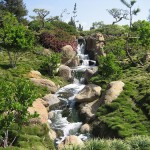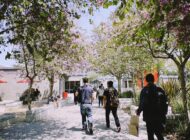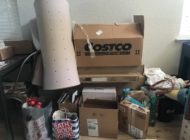Dry Garden
By LESLIE FLORES
Imagine walking into a Zen-filled garden with three large bodies of water and a stone path to guide along the six and a half acres of land. This Zen-filled place is the Japanese Garden, located at 6100 Woodley Ave., in the heart of Balboa Park in the city of Van Nuys.
The Japanese Garden was established in 1984 by Dr. Koichi Kawana, known as the “Renaissance man.” Dr. Kawana did everything from architecture, art, writing books and poetry. He was also a teacher who implemented plans, which are still used today.
According to Jan Abrams, Docent and Gift Shop volunteer at the Japanese Garden, “Docents are tour guides who undergo rigorous training to highlight the key points that Dr. Kawana wanted taught at the garden.
The Japanese Garden was also created in collaboration with Donald C. Tillman’s Water Reclamation Plant, which treats 80 million gallons of sewage through seven steps in eleven and a half hours.
“Visitors who walk into the Japanese Garden experience a whole new world with a feeling of tranquility away from the busy city noise into a place with clean fresh air and well kept plants surrounded by Japanese Koi fish filled waters,” explained Abrams.
In addition to the fish filled waters, there are exotic animals found at the Japanese Garden including swallows, ducks, cranes and pelicans. “I was surprised at the amount of animals present in a beautiful crisp area because the valley is seen as a hot desert-like place,” said Luisa Iturbide, a first-time Garden visitor. “To walk into this attractive scenery is amazing,” Iturbide added.
“Along with the exotic animals, the Garden is a reflection of the Japanese culture featuring a crane that symbolizes honor and loyalty along with the swallow representing luck,” Iturbide pointed out.
The Garden also contains detailed lanterns and waterfalls positioned in a three-tier manner representing the sky on top…the man in the middle and the earth on the bottom. The admission price to the Garden is $3 for adults and $2 for children under 10 and seniors over 62 provides the guest with a half mile walk to surely mesmerize all ages and backgrounds.
“Many of the volunteers are retirees who have a fondness for the garden. They enjoy the environment enough to work in it and have an interest in the Japanese culture,” Abrams said. “Volunteers keep the garden up to par. The fees paid at the Garden entrance help to pay for the maintenance of the place,” Abrams noted.
“The Japanese Garden houses a well-preserved tea house for show and a tea garden,” Abrams revealed. “The tea house oversees the shimmering lakes, green crane island and waterfalls through the large paper mashe windows that take up all sides of the walls. The tea house is empty because it captures the serenity of the moment without any violence.”
Adams described the garden as a place that is “meant to resemble the Japanese art and culture in a home away from home type of feeling while hosting many private events, comprised of weddings, family outings and celebrations. The directional stones found upon entering the garden, lead guests into many Japanese inspired themes, such as a dry garden with stones arranged a certain way on purpose to symbolize happiness and the five basic elements that make up life: wind, water, sky, fire and earth.”
Abrams said: “The Garden is a gift to the San Fernando Valley. If it wasn’t for the city enforcing a garden with the building of a reclamation plant to purify the waters, then there would not be such a wonderful place to escape to and free our minds.”
According to CSUN Urban Studies and Planning Professor Ashwani Vasishth, “In addition to the tea house, a Water Reclamation Plant is located at the Gardens. The Water Reclamation Plant is a good thing to have here. The more water there, the better we are.”
Professor Vasishth explained that “the water reclamation plant uses areas of wetlands to purify water. The clean reclamation plant water is used for the Japanese Garden, Balboa Park and certain wildlife lakes. Japanese people and various ethnic groups in the surrounding community will definitely be able to identify with the Garden and perhaps appreciate the San Fernando Valley even more.”
For further information concerning the Japanese Garden, call 818/756-8166 for Docent led tours.
The Japanese Garden is located at 6100 Woodley Ave., Van Nuys, CA 91406 or one call 818/756-8166 for Docent led tours.
Photostream by LESLIE FLORES
Map of all the places featured in Van Nuys by El Nuevo Sol:
View Van Nuys at LABeez.org and ElNuevoSol.net in a larger map
Tags: Ashwani Vasishth Balboa Park CSUN Donald C. Tillman’s Water Reclamation Plant Japanese Garden Leslie Flores Van Nuys




















